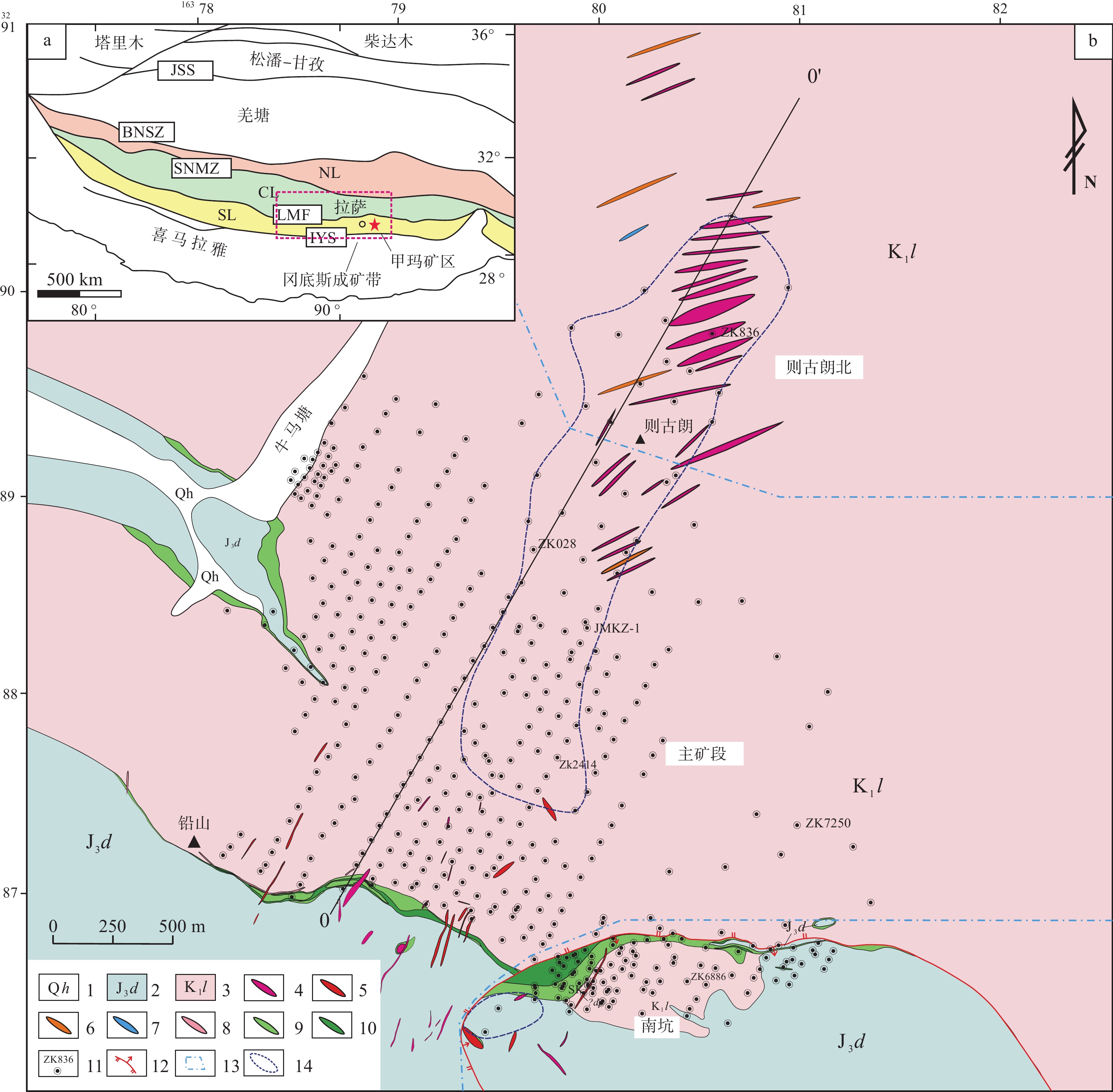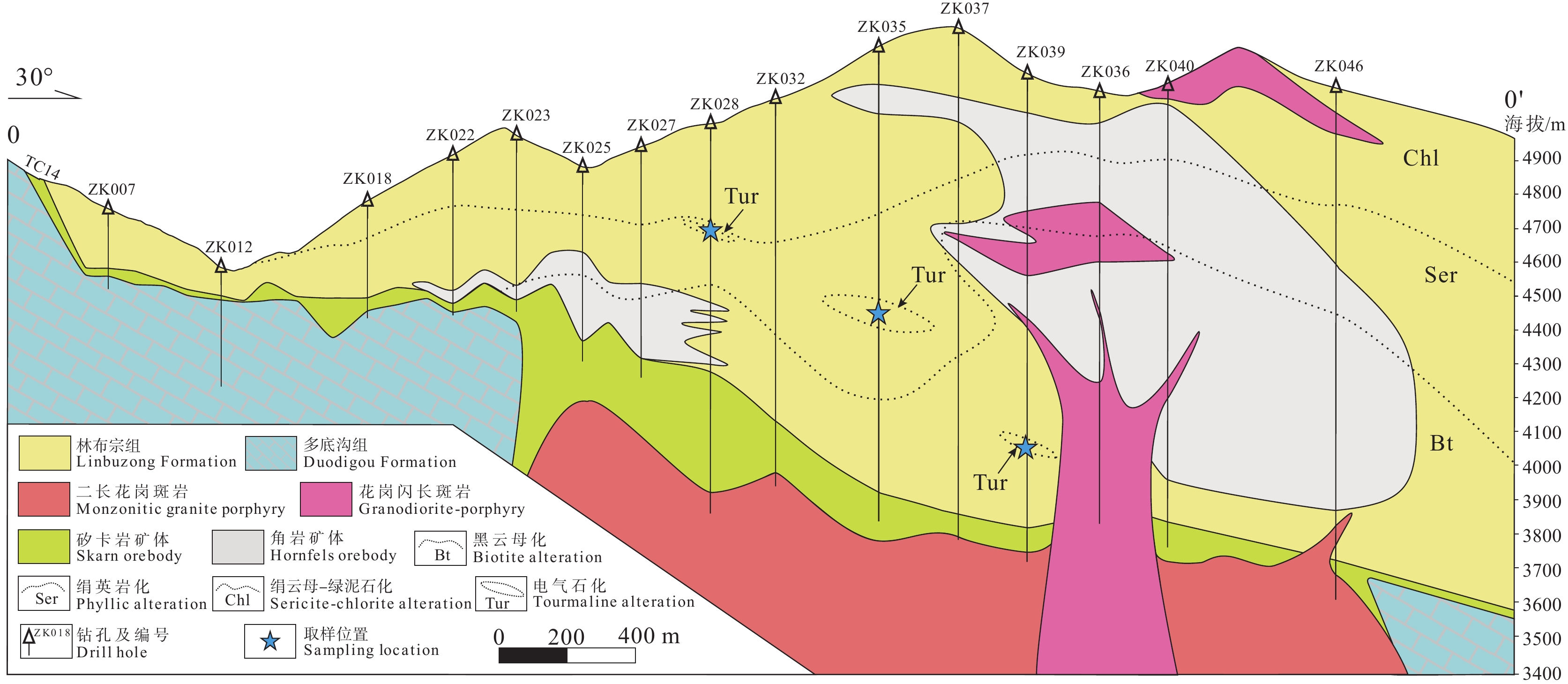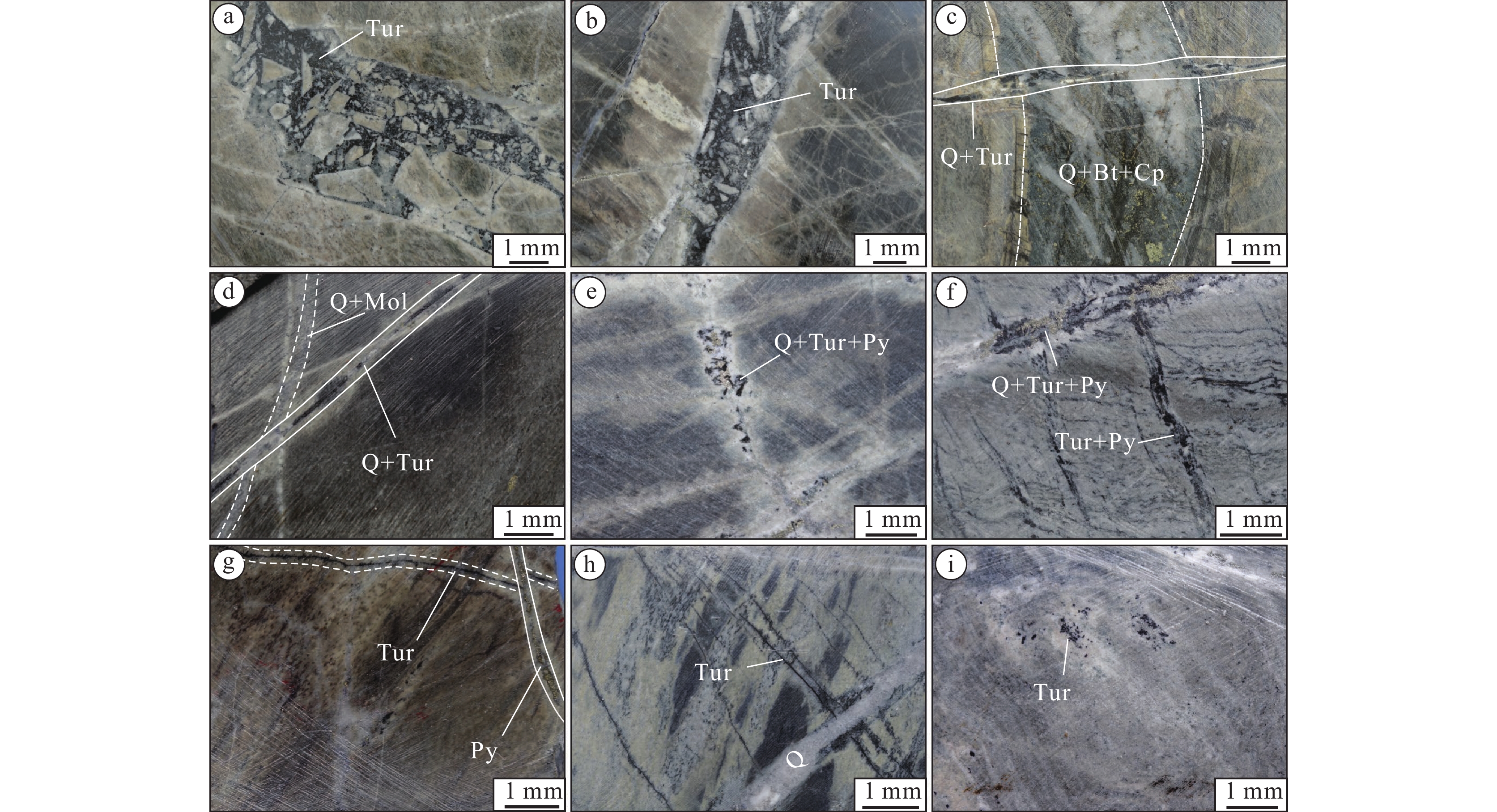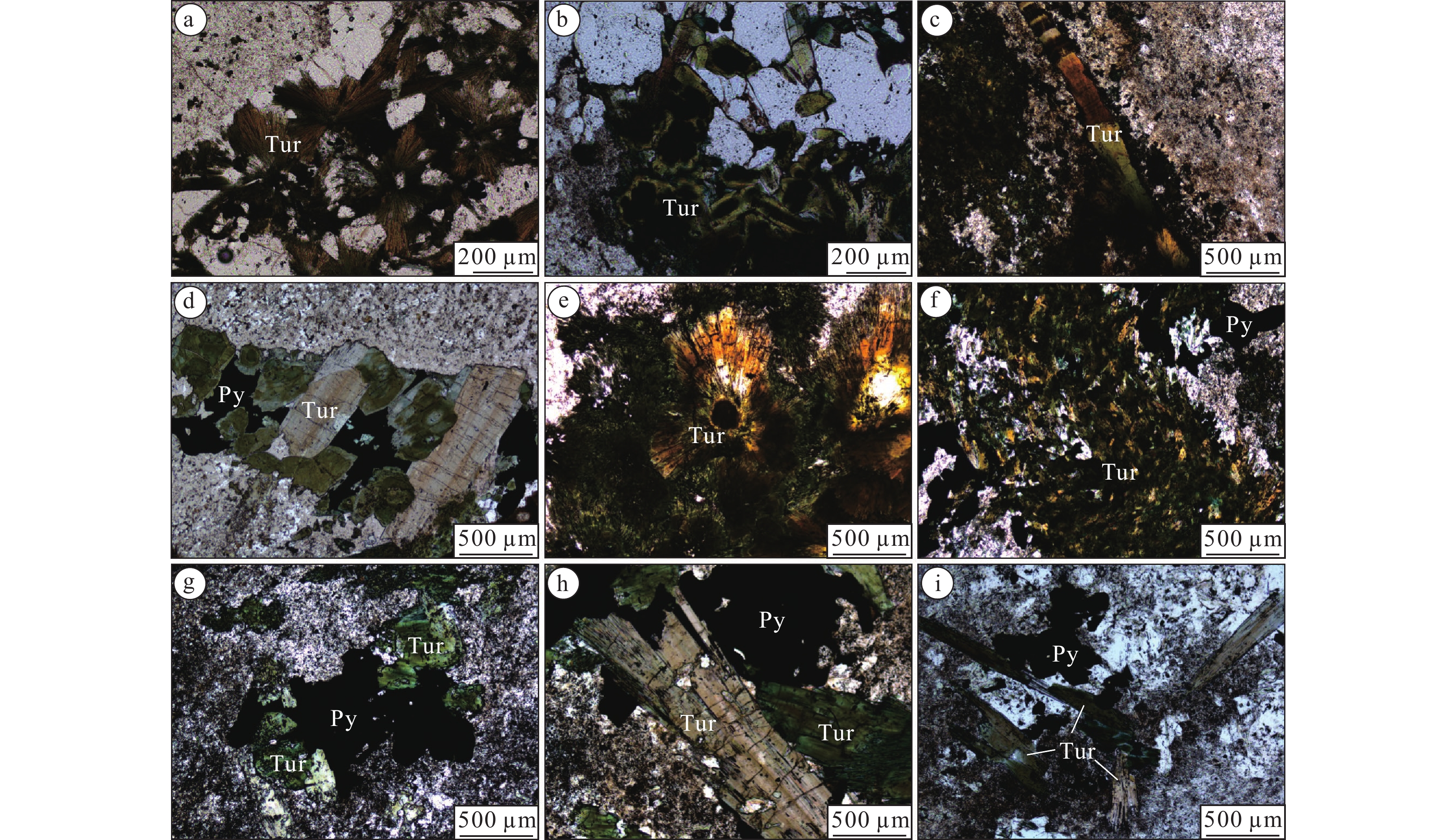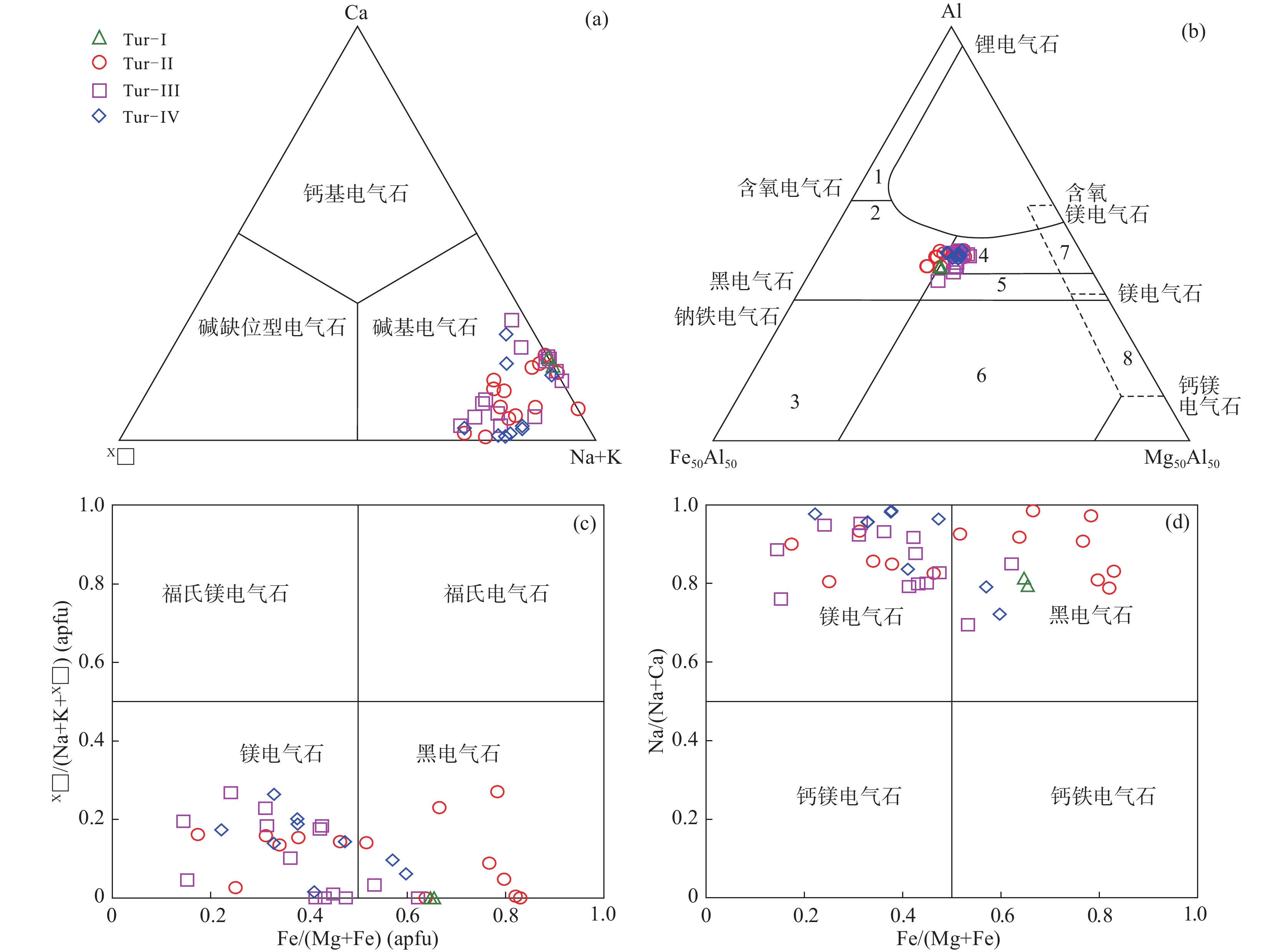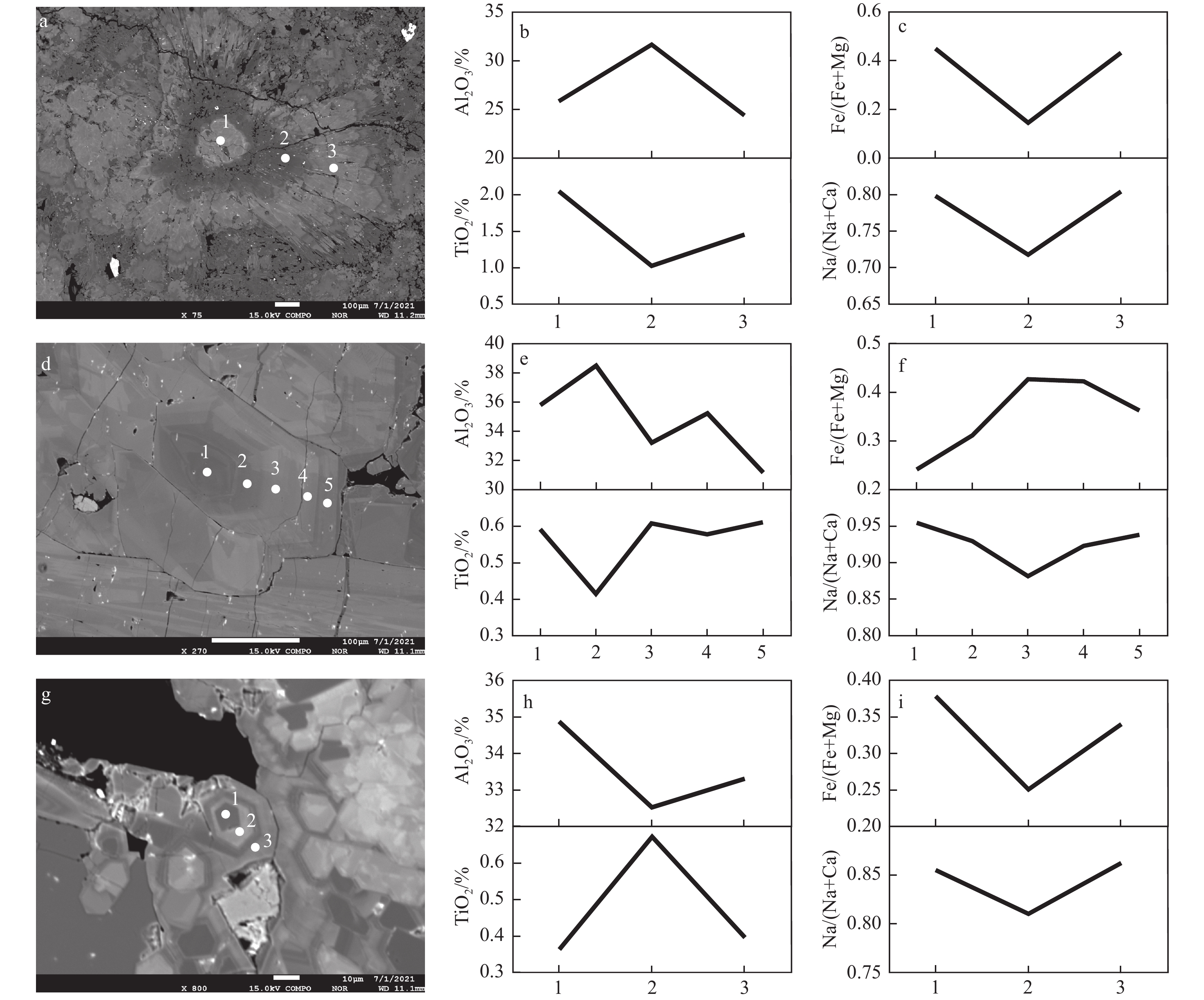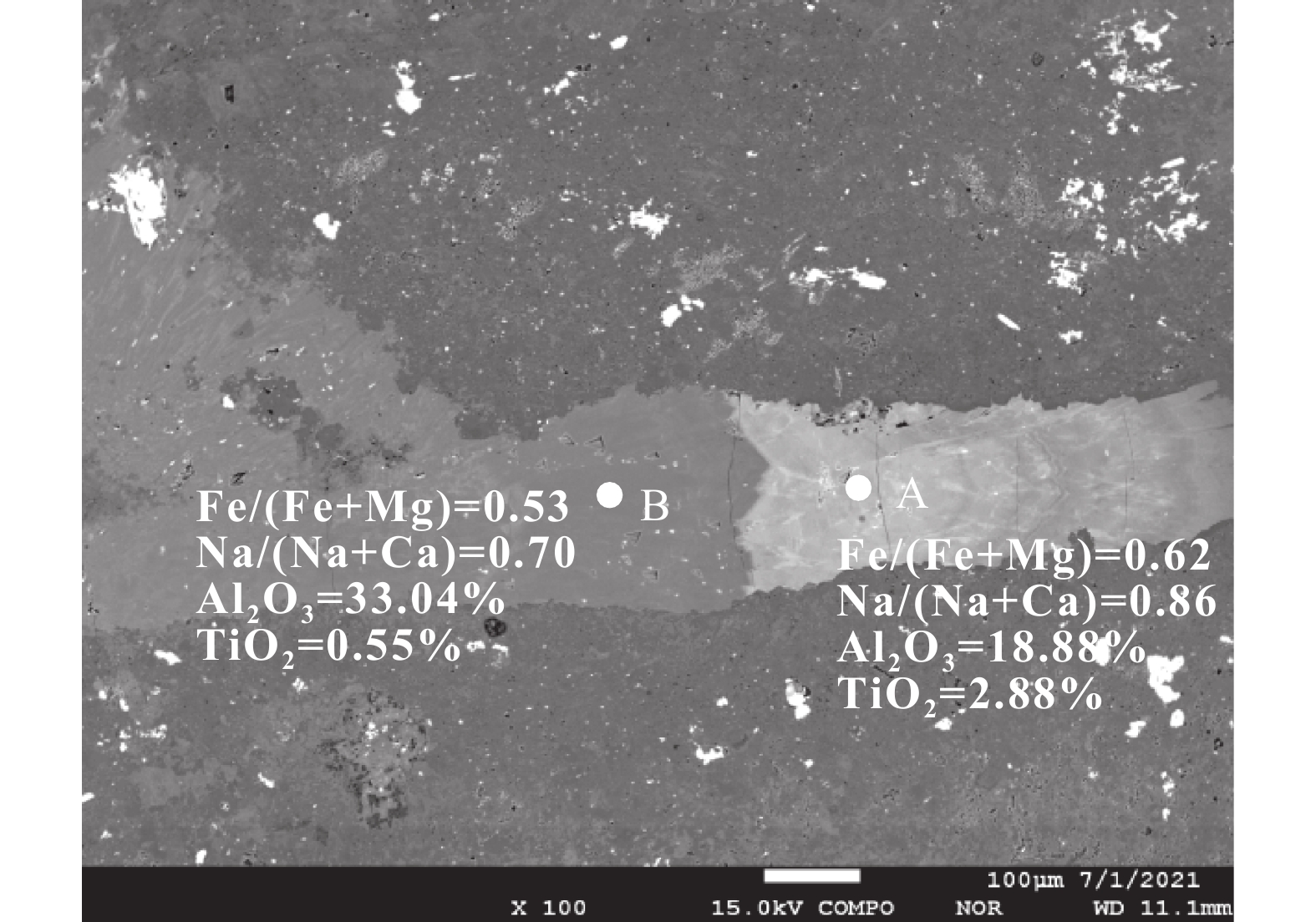Mineralogical characteristics of tourmaline in the Jiama copper polymetallic deposit, Tibet: Insights into hydrothermal evolution
-
摘要:研究目的
角岩作为甲玛超大型斑岩铜多金属成矿系统的重要组成部分,既是成矿热液的岩性圈闭,也是重要的赋矿围岩,但角岩中的电气石成因不明,对于进一步理解成矿过程有一定制约。
研究方法本文通过详细的钻孔编录、镜下鉴定和电子探针分析,研究电气石的成因,并探讨其对岩浆热液流体演化过程的启示。
研究结果电气石在甲玛角岩中较为发育,依据其产状可分为4类:Tur−I,热液角砾岩胶结物中的电气石;Tur−II,石英+电气石±黄铁矿脉;Tur−III,电气石±黄铁矿±黄铜矿脉;Tur−IV,团斑状电气石±黄铁矿;其中前3类电气石较发育环带结构。不同产状电气石均具有较为宽泛的Al2O3、Fe/(Fe+Mg)和Na/(Na+Ca)比值,属于碱基亚类镁电气石和黑电气石,替代机制为X□Al(NaMg)−1、Fe2+Mg−1和Fe3+Al−1。
结论不同产状电气石发育复杂的环带结构,且成分变化极大,表明其是岩浆热液流体和地层流体不同程度混合造成的,且岩浆热液流体与还原性的角岩地层发生的水岩反应可能在甲玛成矿过程中起了重要作用。甲玛不同产状电气石的结构和成分信息记录了岩浆热液演化过程的细节信息,为完善成矿过程提供了重要证据。
创新点:不同产状电气石的结构和成分信息示踪斑岩成矿系统热液演化过程。
Abstract:This paper is the result of mineral exploration engineering.
ObjectiveHornfels, as an important part of the Jima porphyry copper polymetallic system, is host rocks and a lithologic trap for ore−forming fluid. However, the origin of tourmaline in hornfels is unknown, which restricts the further understanding of the mineralization.
MethodsWe carried out detailed drilling logging, petrographic observations and major element analyses of tourmaline with distinctive occurrences in hornfels from the Jiama deposit to elucidate the genesis of tourmaline and evolution of magmatic hydrothermal fluids.
ResultsFour types of tourmalines in hornfels from the Jiama deposit have been identified in this study: 1) Tur−I, tourmaline occurring as cement in hydrothermal breccias; 2) Tur−II, quartz + tourmaline ± pyrite vein; 3) Tur−III, tourmaline ± pyrite ± chalcopyrite vein; 4) porphyritic tourmaline ± pyrite. Tourmaline with distinctive occurrences in hornfels, which belongs to alkali group and dravite−schorl solid solution series, has a wide range of Al2O3, Fe/(Fe+Mg) and Na/(Na+Ca). X□Al(NaMg)−1, Fe2+Mg−1 and Fe3+Al−1 exchange dominates the substitutions of Tur−I−IV.
ConclusionsTourmaline in hornfels with complicated zoning texture has a very variable compositions, indicating that the tourmaline is caused by different degrees of mixing of magmatic hydrothermal fluid and formation fluid, and the water−rock interaction between magmatic hydrothermal fluid and reduced hornfels may play an important role on the mineralization. The various textures and compositions of tourmaline with distinctive occurrences in hornfels from Jiama record some detailed information related to evolution of magmatic hydrothermal fluid, and can provides evidence for understanding the mineralization.
Highlights:The various textures and compositions of tourmaline trace evolution of magmatic hydrothermal fluid.
-
1. 研究目的(Objective)
湘中坳陷作为南方复杂构造区页岩气勘探的热点地区之一,也是中国油气勘探久攻未克的地区。前期在湘中地区北部的涟源凹陷泥盆系和石炭系获得了页岩气突破和发现,证实了湘中地区上古生界页岩气资源丰富。但对湘中地区南部的邵阳凹陷调查程度较为薄弱,针对邵阳凹陷二叠系仅开展了少量基础地质调查工作,页岩气资源潜力评价方面的工作尤为欠缺。本次研究依托邵阳湘邵地1井(XSD1井)钻探工程建立了邵阳凹陷二叠系地层层序序列,揭示了主要含气页岩层系的分布特征,获取了含气性评价参数,对湘中地区二叠系页岩气勘探开发和重新评价湘中坳陷页岩气资源潜力具有重要的现实意义。
2. 研究方法(Methods)
中国地质调查局武汉地质调查中心在收集分析区域地质相关资料的基础上,结合邵阳凹陷短陂桥向斜的煤田浅钻、非震物探等资料开展页岩气地质综合评价,采用页岩埋深500~4500 m,页岩有机碳含量≥1.0%,页岩厚度≥15 m,页岩有机质热演化程度1.0%~3.5%的评价参数在短陂桥向斜区优选页岩气远景区,论证部署了1口小口径页岩气地质调查井—XSD1井,湖南煤田地质勘查有限公司组织实施钻探(图 1a)。该井采样全井段取心钻井工艺,测井选取PSJ-2数字测井系统,录井采用SK-2000G气测录井,钻获二叠系大隆组156.05 m(暗色硅质页岩、钙质泥岩94.48 m),龙潭组349.95 m(暗色泥岩216.93 m,粉砂质泥岩36.9 m),对这两套层系共采集暗色泥岩样品33件,进行解析气含量测定分析,落实了含气性评价参数。
3. 结果(Results)
本次样品分析工作由武汉地质调查中心古生物与生命-环境协同演化重点实验室完成,采用YSQ-IIIA岩石解析气测定仪(燃烧法)对含气段岩心共计33件样品进行分析。该井钻获二叠系大隆组厚度156.05 m,为一套硅质岩、硅质页岩、炭质钙质泥岩地层。其中在井深842~930.2 m硅质页岩、钙质泥岩段,气测全烃值从1.06%上升至16.54%,甲烷值从1.01%上升至14.04%,13件大隆组硅质页岩现场解析总含气量为1.29~9.97 m3/t,平均4.85 m3/t。实现了湘中坳陷二叠系页岩气新发现,有效拓展了华南地区大隆组勘探范围。
钻获龙潭组厚度349.95 m,上段为一套细砂岩、粉砂岩夹泥岩潮坪相沉积地层,下段为一套炭质泥岩、粉砂质泥岩夹薄层细砂岩泻湖相沉积地层。在井深1013.4~1048 m泥岩与粉砂岩互层段气测全烃值最高可达19.87%,甲烷值最高为16.94%,7件泥岩与粉砂岩样品现场解析总含气量0.57~3.42 m3/t,平均1.78 m3/t;井深1088.10~1199.75 m泥岩夹泥质粉砂岩含气层111.6 m,气测全烃值最高可达28.2%,甲烷值最高为23.6%,13件泥岩、粉砂质泥岩样品现场解析总含气量0.90~4.55 m3/t,平均2.01 m3/t(图 1b),首次查明了湘中坳陷二叠系龙潭组非常规油气分布特点。
通过区域地质背景分析,并结合煤田区域地质资料,本研究认为滑脱断裂(F9)上下盘具有不同的页岩气聚集条件。滑脱断裂之上由一系列的同向逆断层形成的逆冲推覆体,地层变形强烈,且裂缝发育,导致页岩气保存条件变差。滑脱断裂下盘是页岩气主要富集区,地层平缓,不发育次级通天断裂,与下盘地层形成反向遮挡,易形成封闭,保存条件良好(图 1c)。
4. 结论(Conclusions)
(1)二叠系大隆组岩性以硅质岩、硅质页岩为主,夹少量灰岩。主要含气段存在于上段硅质页岩段,厚88.2 m,含气量平均为4.85 m3/t,含气性优越,资源潜力大。
(2)二叠系龙潭组上段以致密砂岩气为主,含气量平均为1.78 m3/t;下段以页岩气为主,泥岩厚达177.47 m,含气量平均为2.01 m3/t,具有泥岩厚度大,含气性好等特征。
(3)保存条件是页岩气富集关键,构造改造弱的封闭演化环境有利于页岩气保存,研究区滑脱断裂下盘是页岩气主要富集区,易形成封闭,保存条件良好。
(4)湘邵地1井在二叠系大隆组和龙潭组获得良好的页岩气显示,证实了湘中地区二叠系具有良好的页岩气资源潜力,对湘中地区页岩气资源潜力评价具有重要意义。
5. 基金项目(Fund support)
本文为中国地质调查局项目“中扬子地区油气页岩气调查评价”(DD20221659)资助的成果。
-
图 1 甲玛矿区大地构造位置简图(a)及地质图(b)(据唐菊兴等,2010修改)
1—第四系残坡积物;2—多底沟组大理岩、灰岩;3—林布宗组板岩、角岩;4—花岗闪长斑岩;5—花岗斑岩;6—石英闪长玢岩;7—煌斑岩;8—细晶岩;9—矽卡岩;10—矽卡岩矿体;11—钻孔及编号;12—滑覆构造;13—矿段;14—隐伏岩体范围;JSS—金沙江缝合带;BNSZ—班公湖—怒江缝合带;SNMZ—狮泉河—嘉黎蛇绿岩混杂岩带;LMF—洛巴堆—米拉山断裂带;IYS—印度—雅鲁藏布江缝合带;SL—南拉萨地体;CL—中拉萨地体;NL—北拉萨地体
Figure 1. Tectonic location (a) and geological map (b) of Jiama ore district (modified from Tang Juxing et al., 2010)
1−Quaternary; 2−Marble and limestone of Duodigou Formation; 3−Slatew and hoenfels of Linbuzong Formation; 4−Granodiorite porphyry; 5−Granite porphyry; 6−Quartz diorite porphyry; 7−Lamprophyre; 8−Aplite; 9−Skarn; 10−Skarn ore−body; 11−Drilling and number; 12−Slip fault; 13−Segment of mining; 14−Concealed intrusive outline; JSS−Jinsha suture zone; BNSZ−Bangong−Nujiang suture zone; SNMZ−Shiquan River−Nam Tso mélange zone; LMF−Luobadui−Milashan Fault; IYS−Indus−Yarlung Zangbo suture zone; SL−Southern Lhasa subterrane; CL−Centhern Lhasa subterrane; NL−Northern Lhasa subterrane
图 3 甲玛矿区不同产状电气石手标本照片
a~b—热液角砾岩胶结物中电气石(Tur−I);c—石英+电气石脉(Tur−II),切穿早期的石英+黑云母+黄铜矿脉;d—石英+电气石脉(Tur−II),切穿早期的石英+辉钼矿脉;e—石英+电气石+黄铁矿脉(Tur−II);f—石英+电气石+黄铁矿脉(Tur−II)和电气石+黄铁矿脉(Tur−III);g—电气石脉(Tur−III),被后期的黄铁矿脉切穿;d—电气石脉(Tur−III),被后期的无矿石英脉切穿;i—团斑状电气石+黄铁矿(Tur−IV);Tur—电气石;Py—黄铁矿;Cp—黄铜矿;Q—石英;Bt—黑云母;Mol—辉钼矿
Figure 3. Hand specimens of tourmalines with different occurrences of Jiama deposit
a−b−Tourmaline occurring as cement in hydrothermal breccias (Tur−I); c−Quartz + tourmaline vein (Tur−II) cutting quartz + biotite + chalcopyrite vein; d−Quartz + tourmaline vein (Tur−II) cutting quartz + molybdenite vein; e−Quartz + tourmaline + pyrite vein (Tur−II); f−Quartz + tourmaline + pyrite vein (Tur−II) and tourmaline + pyrite vein (Tur−III); g−Tourmaline vein (Tur−III) cut by pyrite vein; h−Tourmaline vein (Tur−III) cut by quartz vein; i−Porphyritic tourmaline + pyrite (Tur−IV); Tur−Tourmaline; Py−Pyrite; Cp−Chalcopyrite; Q−Quartz; Bt−Biotite; Mol−Molybdenite
图 4 甲玛矿区不同产状电气石镜下照片
a—热液隐爆角砾岩胶结物中放射状电气石;b—石英+电气石脉,电气石半自形—自形,具有环带结构;c—电气石脉;d—电气石+黄铁矿脉,电气石半自形—自形,具有环带结构;e—电气石脉,电气石呈放射状;f—电气石+黄铁矿脉,电气石呈他形—半自形;g—团斑状电气石+黄铁矿,电气石呈他形;h~i—团斑状电气石+黄铁矿,电气石呈半自形—自形
Figure 4. Microphotos of tourmalines with different occurrences of Jiama deposit
a−Tur−I with radial texture; b−Euhedral to subhedral Tur−II shows distinct zoning texture; c−Fine−grained Tur−III; d−Euhedral to subhedral Tur−III shows distinct zoning texture and coexist with pyrite; e−Tur−III with radial texture; f−Fine−grained, subhedral and anhedral Tur−III coexist with pyrite; g−Anhedral Tur−IV coexist with pyrite; h−i−Subhedral and anhedral Tur−IV coexist with pyrite
图 5 甲玛矿区不同产状电气石分类图解
a—Ca−X□−(Na+K)三元图解(底图据Henry et al., 2011);b—Al−Fe−Mg图解(底图据Henry and Guidotti, 1985),图中1、2区分别代表富Li和贫Li花岗岩和伟晶岩、细晶岩,3区为富Fe3+的石英−电气石岩(热液蚀变花岗岩),4、5区分别代表含Al饱和矿物相和不含Al饱和矿物相的变泥质岩和变砂屑岩,6区代表富Fe3+的石英−电气石岩、钙质硅酸岩和变泥质岩,7区代表贫Ca变质超镁铁岩和富Cr、V的变质沉积岩,8区代表变质碳酸盐和变质辉石;c—Fe/(Fe+Mg)−X□/(Na+K+ X□)图解(底图据Henry et al., 2011);d—Fe/(Fe+Mg)−Na/(Na+Ca)图解(底图据Henry et al., 2011)
Figure 5. Tourmaline discrimination diagrams with different occurrences of Jiama deposit
a−Ca−X□−(Na+K) diagram for tourmaline discrimination (after Henry et al., 2011); b−Plot Al−Fe−Mg for tourmaline from various rock types (after Henry and Guidotti, 1985), 1−Li−rich granitoid pegmatites and aplites; 2−Li−poor granitoid rocks and associated pegmatites and aplites, 3−Fe3+−rich quartz–tourmaline rocks (hydrothermally altered granites); 4−Metapelites and metapsammites coexisting with an Alsaturating phase; 5−Metapelites and metapsammites not coexisting with an Al−saturating phase; 6−Fe3+−rich quartz–tourmaline rocks, calcsilicate rocks, and metapelites; 7−Low−Ca metaultramafic rocks and Cr, V−rich metasediments; 8−Metacarbonates and meta−pyroxenites; c−Fe/(Fe+Mg)−X□/(Na+K+ X□) diagram for tourmaline discrimination (after Henry et al., 2011); d−Fe/(Fe+Mg)−Na/(Na+Ca) diagram for tourmaline discrimination (after Henry et al., 2011)
表 1 甲玛矿区不同产状电气石电子探针分析结果(%)
Table 1 Compositions of tourmalines (%) with different occurrences of Jiama deposit
编号 JM-
233-1JM-
233-2028-
330-
1A028-
330-
1B028-
330-
1C028-
357-
1028-
357-
1A028-
357-
11A028-
357-
11B028-
357-
11C028-
357-
2028-
357-
3JM-
155-
1AJM-
155-
1BJM-
155-
2AJM-
155-
2BJM-
275-
1AJM-
275-
1BJM-
275-
1CJM-
275-
2A产状 Tur−I Tur−II 点位 核部 幔部 边部 核部 边部 核部 边部 核部 边部 核部 幔部 边部 核部 SiO2 30.29 30.3 36.03 33.38 35.52 35.76 33.43 32.84 33.4 36.64 34.9 34 36.09 35.89 35.84 35.14 34.53 31.35 33.1 34.87 TiO2 0.9 0.56 0.25 1.49 0.38 0.05 0.29 0.23 0.41 0.27 0.75 0.15 0.7 0.56 0.62 1.2 1.85 1.29 1.57 2.05 Al2O3 24.37 24.88 34.87 32.52 33.31 31.26 25.07 22.95 23.89 34.69 33.36 31.41 33.11 37.61 32.77 32.7 22.14 32.04 27.08 25.84 FeO 17.23 16.81 6.98 5.79 6.38 16.91 21.78 15.68 20.62 6.72 9.62 17.68 13.12 3.19 13.17 9.94 13.64 3.06 10.31 12.52 MgO 5.1 5.14 6.43 9.71 6.95 2.88 2.51 5 2.53 8.3 6.25 2.53 3.7 8.51 2.05 5.21 8.46 9.53 8.21 8.61 CaO 1.05 0.97 0.71 1.05 0.67 0.44 0.88 0.4 1.04 0.3 0.82 0.97 0.04 0.47 0.09 0.33 0.92 1.2 1.1 1.05 MnO 0 0 0 0 0.02 0.05 0.05 0 0.03 0.02 0 0.08 0.03 0 0 0 0 0 0 0 Na2O 2.32 2.42 2.33 2.47 2.33 2.58 2.49 2.71 2.22 2.58 2.24 2.35 2.41 2.52 2.2 2.5 2.53 2.16 2.4 2.4 K2O 0.03 0.06 0.01 0.02 0.04 0.03 0.04 0.09 0.03 0.03 0.03 0.05 0.03 0.01 0.04 0.04 0.03 0.02 0.03 0.06 F 0.16 0.04 0.18 0.17 0 0 0.01 0.05 0.02 0 0 0.09 0.09 0.22 0.02 0 0 0.08 0.08 0 Cl 0 0 0 0 0 0 0.01 0 0.01 0 0.01 0 0 0 0 0 0 0 0 0.02 H2O* 3.11 3.18 3.66 3.58 3.66 3.63 3.35 3.25 3.27 3.82 3.68 3.52 3.65 3.76 3.6 3.65 3.39 3.42 3.41 3.55 B2O3* 9.25 9.26 10.85 10.6 10.62 10.52 9.72 9.47 9.51 11.06 10.67 10.34 10.69 11.19 10.47 10.58 9.82 10.03 10 10.31 O=F 0.07 0.01 0.07 0.07 0 0 0 0.02 0.01 0 0 0.04 0.04 0.09 0.01 0 0 0.03 0.03 0 Total* 93.74 93.61 102.38 100.71 100.15 104.12 99.68 95.37 96.98 104.44 102.38 103.15 103.66 103.98 101.25 101.46 97.38 94.2 97.33 101.39 根据31 个阴离子(O, OH, F)计算 T: Si 5.69 5.69 5.77 5.48 5.81 5.91 5.98 6.03 6.11 5.76 5.68 5.72 5.87 5.58 5.95 5.77 6.11 5.43 5.76 5.88 Al 0.31 0.31 0.23 0.52 0.19 0.09 0.02 0 0 0.24 0.32 0.28 0.13 0.42 0.05 0.23 0 0.57 0.24 0.12 B 3 3 3 3 3 3 3 3 3 3 3 3 3 3 3 3 3 3 3 3 Z: Al 5.09 5.19 6 5.76 6 5.99 5.26 4.96 5.15 6 6 5.94 6 6 6 6 4.62 5.97 5.31 5.01 Mg 0.91 0.81 0 0.24 0 0.01 0.67 1.04 0.69 0 0 0.06 0 0 0 0 1.38 0.03 0.69 0.99 Fe3+ 0 0 0 0 0 0 0 0 0 0 0 0 0 0 0 0 0 0 0 0 Y: Al 0 0 0.35 0 0.24 0 0 0 0 0.18 0.09 0 0.21 0.46 0.36 0.11 0 0 0 0 Ti 0.13 0.08 0.03 0.18 0.05 0.01 0.04 0.03 0.06 0.03 0.09 0.02 0.09 0.07 0.08 0.15 0.25 0.17 0.21 0.26 Fe3+ 0 0 0 0 0 0 0 0 0 0 0 0 0 0 0 0 0 0 0 0 Mg 0.51 0.62 1.54 2.14 1.7 0.7 0 0.33 0 1.94 1.52 0.57 0.9 1.97 0.51 1.28 0.85 2.43 1.43 1.17 Mn 0 0 0 0 0 0.01 0.01 0 0.01 0 0 0.01 0 0 0 0 0 0 0 0 Fe2+ 2.71 2.64 0.93 0.79 0.87 2.34 3.26 2.41 3.15 0.88 1.31 2.49 1.78 0.41 1.83 1.37 2.02 0.44 1.5 1.76 ΣY 3.35 3.34 3 3.12 3 3.05 3.31 3.16 3.22 3.05 3.02 3.09 3 3 3 3 3.11 3.04 3.15 3.2 X: Ca 0.21 0.19 0.12 0.18 0.12 0.08 0.17 0.08 0.2 0.05 0.14 0.17 0.01 0.08 0.02 0.06 0.17 0.22 0.21 0.19 Na 0.84 0.88 0.72 0.79 0.74 0.83 0.86 0.96 0.79 0.79 0.71 0.77 0.76 0.76 0.71 0.79 0.87 0.73 0.81 0.79 K 0.01 0.01 0 0 0.01 0.01 0.01 0.02 0.01 0.01 0.01 0.01 0.01 0 0.01 0.01 0.01 0 0.01 0.01 X□ 0 0 0.15 0.03 0.13 0.09 0 0 0 0.16 0.14 0.05 0.23 0.16 0.27 0.14 0 0.05 0 0.01 OH 3.9 3.98 3.91 3.91 4 4 3.99 3.97 3.98 4 4 3.95 3.96 3.89 3.99 4 4 3.96 3.96 3.99 F 0.1 0.02 0.09 0.09 0 0 0.01 0.03 0.01 0 0 0.05 0.04 0.11 0.01 0 0 0.04 0.04 0 Cl 0 0 0 0 0 0 0 0 0 0 0 0 0 0 0 0 0 0 0 0.01 Fe/(Mg+Fe) 0.65 0.65 0.38 0.25 0.34 0.77 0.83 0.64 0.82 0.31 0.46 0.8 0.67 0.17 0.78 0.52 0.47 0.15 0.41 0.45 X□ /(X□+Na+K) 0 0 0.17 0.03 0.15 0.1 0 0 0.01 0.17 0.17 0.06 0.23 0.17 0.27 0.15 0 0.06 0 0.01 编号 JM-
275-
2BJM-
275-
2CJM-
415-
2AJM-
415-
2B035-
848-
1035-
848-
2A035-
848-
2B035-
848-
2C035-
848-
2D035-
848-
2E035-
767-
1035-
767-
2035-
803-
1039-
1112-
1039-
1112-
2039-
1112-
21JM-
415-
3JM-
415-
1AJM-
415-
1B产状 Tur−III Tur−IV 点位 幔部 边部 核部 核部 幔部 幔部 边部 边部 核部 边部 SiO2 33.86 33.87 32.15 26.34 37.19 37.71 36.97 36.54 36.66 36.53 37.05 36.7 36.76 36.16 36.32 36.77 34.42 35.37 29.33 TiO2 1.03 1.46 2.89 0.55 0.52 0.59 0.42 0.61 0.58 0.61 0.41 0.44 0.43 0.44 0.36 0.29 0.58 0.47 0.61 Al2O3 31.66 24.39 18.88 33.04 32.71 35.79 38.5 33.22 35.23 31.17 37.19 31.71 34.36 31.14 28.21 27.9 30.71 31.48 34.93 FeO 3.15 11.28 19.64 10.15 6.77 4.94 6.02 9.05 8.92 8.12 4.1 6.97 6.93 7.84 10.03 8.1 10.27 9.13 12.17 MgO 10.47 8.32 6.69 4.99 8.26 8.72 7.48 6.83 6.85 8.01 8.06 7.99 7.92 7.29 6.26 7.5 4.34 7.35 4.59 CaO 0.48 1.07 0.83 1.44 0.2 0.2 0.33 0.56 0.38 0.32 0.08 0.19 0.16 0.05 0.14 0.04 1 0.88 1.38 MnO 0.02 0.02 0 0 0 0.04 0.06 0 0 0.03 0 0 0.01 0 0.03 0.02 0 0 0 Na2O 2.2 2.43 2.71 1.86 2.52 2.33 2.42 2.31 2.5 2.66 2.71 2.61 2.3 2.44 2.5 2.44 2.15 2.59 2.02 K2O 0.02 0.02 0.07 0.03 0.03 0.02 0.03 0.03 0.02 0.03 0.03 0.03 0.02 0.03 0.03 0.04 0.03 0.03 0.05 F 0 0.16 0 0 0 0.1 0.03 0 0 0.2 0.03 0.18 0 0.01 0 0.1 0.16 0 0 Cl 0 0 0.01 0 0 0 0 0.01 0 0 0 0 0 0 0.01 0 0.01 0 0 H2O* 3.58 3.31 3.23 3.21 3.76 3.85 3.94 3.75 3.84 3.6 3.88 3.61 3.79 3.61 3.53 3.5 3.42 3.65 3.47 B2O3* 10.37 9.82 9.36 9.31 10.9 11.3 11.46 10.88 11.14 10.7 11.28 10.7 10.99 10.49 10.23 10.27 10.14 10.58 10.06 O=F 0 0.07 0 0 0 0.04 0.01 0 0 0.08 0.01 0.07 0 0.01 0 0.04 0.07 0 0 Total* 96.82 96.14 96.47 90.97 102.84 105.59 107.68 103.81 106.16 101.89 104.99 101.17 103.7 99.57 98.12 97.49 97.49 101.53 98.6 根据31 个阴离子(O, OH, F)计算 T: Si 5.68 5.99 5.97 4.92 5.93 5.8 5.6 5.84 5.72 5.94 5.71 5.96 5.81 5.99 6.17 6.22 5.9 5.81 5.07 Al 0.32 0.01 0.03 1.08 0.07 0.2 0.4 0.16 0.28 0.06 0.29 0.04 0.19 0.01 0 0 0.1 0.19 0.93 B 3 3 3 3 3 3 3 3 3 3 3 3 3 3 3 3 3 3 3 Z: Al 5.93 5.08 4.1 6 6 6 6 6 6 5.91 6 6 6 6 5.65 5.56 6 5.9 6 Mg 0.07 0.92 1.85 0 0 0 0 0 0 0.09 0 0 0 0 0.35 0.44 0 0.1 0 Fe3+ 0 0 0 0 0 0 0 0 0 0 0 0 0 0 0 0 0 0 0 Y: Al 0 0 0 0.18 0.08 0.29 0.48 0.09 0.2 0 0.46 0.04 0.21 0.07 0 0 0.1 0 0.18 Ti 0.13 0.19 0.4 0.08 0.06 0.07 0.05 0.07 0.07 0.07 0.05 0.05 0.05 0.06 0.05 0.04 0.07 0.06 0.08 Fe3+ 0 0 0 0 0 0 0 0 0 0 0 0 0 0 0 0 0 0 0 Mg 2.55 1.27 0 1.39 1.96 2 1.69 1.63 1.59 1.84 1.85 1.93 1.87 1.8 1.23 1.46 1.11 1.7 1.18 Mn 0 0 0 0 0 0 0.01 0 0 0 0 0 0 0 0 0 0 0 0 Fe2+ 0.44 1.67 3.05 1.58 0.9 0.64 0.76 1.21 1.16 1.1 0.53 0.95 0.92 1.09 1.42 1.15 1.47 1.25 1.76 ΣY 3.12 3.15 3.45 3.24 3.01 3 3 3 3.03 3.03 3 3 3.05 3.01 3 3 3 3.02 3.2 X: Ca 0.09 0.2 0.16 0.29 0.03 0.03 0.05 0.1 0.06 0.06 0.01 0.03 0.03 0.01 0.03 0.01 0.18 0.16 0.25 Na 0.71 0.83 0.97 0.67 0.78 0.7 0.71 0.71 0.76 0.84 0.81 0.82 0.71 0.78 0.82 0.8 0.72 0.82 0.68 K 0 0 0.02 0.01 0.01 0 0.01 0.01 0 0.01 0.01 0.01 0 0.01 0.01 0.01 0.01 0.01 0.01 X□ 0.19 0 0 0.03 0.18 0.27 0.23 0.18 0.17 0.1 0.17 0.14 0.26 0.2 0.14 0.19 0.1 0.01 0.06 OH 4 3.91 4 4 4 3.95 3.99 4 4 3.9 3.99 3.91 4 3.99 4 3.95 3.91 4 4 F 0 0.09 0 0 0 0.05 0.01 0 0 0.1 0.01 0.09 0 0.01 0 0.05 0.09 0 0 Cl 0 0 0 0 0 0 0 0 0 0 0 0 0 0 0 0 0 0 0 Fe/(Mg+Fe) 0.14 0.43 0.62 0.53 0.31 0.24 0.31 0.43 0.42 0.36 0.22 0.33 0.33 0.38 0.47 0.38 0.57 0.41 0.6 X□ /(X□+Na+K) 0.21 0 0 0.05 0.19 0.28 0.24 0.2 0.19 0.11 0.17 0.14 0.27 0.2 0.15 0.19 0.12 0.02 0.08 -
[1] Allegre J, Courtillot V, Tapponnier P, Hirn A, Mattauer M, Coulon C, Jaeger J J, Achache J, Scharer U, Marcoux J, Burg J P, Girardeau J, Armijo R, Gariepy C, Gopel C, Li T, Xiao X C, Chang C F. 1984. Structure and evolution of the Himalaya–Tibet orogenic belt[J]. Nature, 307: 17−22. doi: 10.1038/307017a0
[2] Baksheev I A, Prokofev V Y, Zaraisky G P, Chitalin A F, Yapaskurt V O, Nikolaev Y N, Tikhomirov P L, Nagornaya E V, Rogacheva L l, Gorelikova N V, Kononov O V. 2012. Tourmaline as a prospecting guide for the porphyry−styledeposits[J]. European Journal of Mineralogy, 24(6): 957−979. doi: 10.1127/0935-1221/2012/0024-2241
[3] Chung S L, Chu M F, Zhang Y Q, Xie Y W, Lo C H, Lee T Y, Lan C Y, Li X H, Zhang Q, Wang Y Z. 2005. Tibetan tectonic evolution inferred from spatial and temporal variations in post−collisional magmatism[J]. Earth−Science Reviews, 68: 173−196.
[4] Codeço M S, Weis P, Trumbull R B, Pinto F, Lecumberri−Sanchez P, Wilke F D H. 2017. Chemical and boron isotopic composition of hydrothermal tourmaline from the Panasqueira W−Sn–Cu deposit, Portugal[J]. Chemical Geology, 468: 1−16. doi: 10.1016/j.chemgeo.2017.07.011
[5] Dutrow B L, Henry D J. 2011. Tourmaline: A geologic DVD[J]. Elements, 7: 301−306. doi: 10.2113/gselements.7.5.301
[6] Feng Yonggang, Liang Ting, Wang Mengxi, Zhang Ze, Hao Yuanyuan, Cen Jubiao, Dong Ziyan. 2022. Geochemistry of tourmaline from granitic pegmatites in East Qinling and its implications for mineralization[J]. Acta Petrologica Sinica, 38(2): 428−444 (in Chinese with English abstract).
[7] Griffin W L, Slack J F, Ramsden A R, Qin T T, Ryan C G. 1996. Trace elements in tourmalines from massive sulfides deposits and tourmalinites: Geochemical controls and exploration applications[J]. Economic Geology, 91(4): 657−675. doi: 10.2113/gsecongeo.91.4.657
[8] Guo Jia, Yan Haibo, Ling Mingxing, Zhang Rongqing. 2020. Chemical composition of tourmaline in the biotite granite, the Dachang district: Insights into magmatic−hydrothermal evolution[J]. Acta Petrologica Sinica, 36(1): 171−183 (in Chinese with English abstract). doi: 10.18654/1000-0569/2020.01.16
[9] Guo Wenbo, Zheng Wenbao, Tang Juxing, Ying Lijuan, Wang Yiyun, Lin Bin. 2014. Geochemical constraints on the source of metallogenic fluids and materials in the Jiama polymetallic Cu deposit, Tibet[J]. Geology in China, 41(2): 510−528 (in Chinese with English abstract).
[10] Gupta S, Jayananda M, Fareeduddin. 2014. Tourmaline from the Archean G. R. Halli gold deposit, Chitradurga greenstone belt, Dharwar craton (India): Implications for the gold metallogeny[J]. Geoscience Frontiers, 5(6): 877−892. doi: 10.1016/j.gsf.2013.12.004
[11] Han J S, Hollings P, Jourdan F, Zeng Y C, Chen H Y. 2020. Inherited Eocene magmatic tourmaline captured by the Miocene Himalayan leucogranites[J]. American Mineralogist, 105: 1436−1440. doi: 10.2138/am-2020-7608
[12] Harlaux M, Kouzmanov K, Gialli S, Laurent O, Rielli O, Dini A, Chauvet A, Menzies A, Kalinaj M, Fontbot´e L. 2020. Tourmaline as a tracer of late−magmatic to hydrothermal fluid evolution: The world−class San Rafael tin (−copper) deposit, Peru[J]. Economic Geology, 115: 1665−1697. doi: 10.5382/econgeo.4762
[13] Henry D J, Guidotti C V. 1985. Tourmaline as a petrogenetic indicator mineral: an example from the staurolite−grade metapelites of NW Maine[J]. American Mineralogist, 70: 1−15.
[14] Henry D J, Dutrow B L. 1996. Metamorphic tourmaline and its petrologic applications[J]. Reviews in Mineralogy and Geochemistry, 33: 503−558.
[15] Henry D J, Novák M, Hawthorne F C, Ertl A, Dutrow B L, Uher P, Pezzotta F. 2011. Nomenclature of the tourmaline−supergroup minerals[J]. American Mineralogist, 96: 895−913. doi: 10.2138/am.2011.3636
[16] Hinsberg V J V, Henry D J, Marschall H R. 2011. Tourmaline: An ideal indicator of its host environment[J]. The Canadian Mineralogist, 49: 1−16. doi: 10.3749/canmin.49.1.1
[17] Hou Z Q, Ma H W, Zaw K, Zhang Y Q. 2003. The Himalayan Yulong porphyry copper belt: Product of large−scale strike−slip faulting in Eastern Tibet[J]. Economic Geology, 98(1): 125−145.
[18] Hou Zengqian, Yang Zhusen, Xu Wenyi, Mo Xuanxue, Ding Lin, Gao Yongfeng, Dong Fangliu, Li Guangming, Qu Xiaoming, Zhao Zhidan, Jiang Sihong, Meng Xiangjin, Li Zhenqing, Qin Kezhang, Yang Zhiming. 2006. Metallogenesis in Tibetan collisional orogenic belt: I. Mineralization in main−collisional transformation setting[J]. Mineral Deposits, 25 (4): 337–358 (in Chinese with English abstract).
[19] Jia R X, Fang W X, Hu R Z. 2010. Mineral geochemical compositions of tourmalines and their significance in the Gejiu Tin polymetallic deposits, Yunnan, China[J]. Acta Geologica Sinica, 84(1): 155−166. doi: 10.1111/j.1755-6724.2010.00177.x
[20] Lang X H, Tang J X, Li Z J, Huang Y, Ding F, Yang H H, Zhou Y. 2014. U–Pb and Re–Os geochronological evidence for the Jurassic porphyry metallogenic event of the Xiongcun district in the Gangdese porphyry copper belt, southern Tibet, PRC[J]. Journal of Asian Earth Sciences, 79: 608−622. doi: 10.1016/j.jseaes.2013.08.009
[21] Launay G, Sizareta S, Guillou−Frottier L, Gloaguen E, Pinto F. 2018. Deciphering fluid flow at the magmatic−hydrothermal transition: A case study from the world−class Panasqueira W–Sn–(Cu) ore deposit (Portugal)[J]. Earth and Planetary Science Letters, 499: 1−12. doi: 10.1016/j.jpgl.2018.07.012
[22] Li Zhenzhen, Qin Kezang, Pei Bin, Zhao Junxing, Shi Ruize, Zhao Zelong, Han Ri. 2020. Mineralogical features of tourmaline in Baiyinchagan Sn−Ag−Pb−Zn deposit, southern Great Xing'an Range, and its implications for magmatic−hydrothermal evolution[J]. Acta Petrologica Sinica, 36(12): 3797−3812 (in Chinese with English abstract).
[23] Lin Bin, Tang Juxing, Tang Pan, Zheng Wenbao, Greg Hall, Chen GuoLiang, Zhang Zhongkun. 2019. Polycentric complex mineralization model of porphyry system: A case study of Jiama superlarge deposit in Tibet[J]. Mineral Deposits, 38(6): 1204−1222 (in Chinese with English abstract).
[24] Lin Bin, Tang Juxing, Tang Pan, Zhou Aorigele, Sun Miao, Qi Jing, Chen Guoliang, Zhang Zhongkun, Zhang Zebin, Wu Chunneng, Tian Zhichao, Dai Jingjing, Yang Zhengkun, Yao Xiaofeng. 2021. Preliminary study of first 3000 m scientific drilling in Jiama porphyry metallogenic system, Tibet[J]. Mineral Deposits, 40(6): 1119−1134 (in Chinese with English abstract).
[25] London D, Manning D A C. 1995. Chemical variation and significance of tourmaline from Southwest England[J]. Economic Geology, 90(3): 495−519. doi: 10.2113/gsecongeo.90.3.495
[26] Mo X X, Hou Z Q, Niu Y L, Dong G C, Qu X M, Zhao Z D, Yang Z M. 2007. Mantle contributions to crustal thickening during continental collision: Evidence from Cenozoic igneous rocks in southern Tibet[J]. Lithos, 96: 225−242. doi: 10.1016/j.lithos.2006.10.005
[27] Mo X X, Niu Y L, Dong G C, Zhao Z D, Hou Z Q, Zhou S, Ke S. 2008. Contribution of syncollision felsic magmatism to continental crust growth: A case study of the Paleogene Linzizong vocanic succession in southern Tibet[J]. Chemical Geology, 250: 49−67. doi: 10.1016/j.chemgeo.2008.02.003
[28] Novák M, Koda R, Filip J, Macek I, Vaculovi T. 2011. Compositional trends in tourmaline from intragranitic NYF pegmatites of the terbic pluton, Czech Republic: An electron microprobe, Mossbauer and LA−ICP−MS study[J]. The Canadian Mineralogist, 49(1): 359−380.
[29] Qiu K F, Yu H C, Hetherington C, Huang Y Q, Yang T, Deng J. 2021. Tourmaline composition and boron isotope signature as a tracer of magmatic−hydrothermal processes[J]. American Mineralogist, 106: 1033−1044. doi: 10.2138/am-2021-7495
[30] Slack J F, Trumbull R B. 2011. Tourmaline as a recorder of oreforming processes[J]. Elements, 7: 321−326.
[31] Tang Juxing, Deng Shilin, Zheng Wenbao, Ying Lijuan, Wang Xiongwu, Zhong Kanghui, Qin Zhipeng, Ding Feng, Li Fengji, Tang Xiaoqian, Zhong Yufeng, Peng Huijuan. 2011. An exploration model for Jiama copper polymetallic deposit in Maizhokunggar County, Tibet[J]. Mineral Deposits, 30(2): 179−196 (in Chinese with English abstract).
[32] Tang Juxing, Duo Ji, Liu Hongfei, Lang Xinghai, Zhang Jinshu, Zheng Wenbao, Ying Lijuan. 2012. Minerogenetic series of ore deposits in the east part of the Gangdise metallogenic belt[J]. Acta Geoscientia Sinica, 33(4): 393−410 (in Chinese with English abstract).
[33] Tang Juxing, Wang Denghong, Wang Xiongwu, Zhong Kanghui, Ying Lijuan, Zheng Wenbao, Li Fengjie, Guo Na, Qin Zhipeng, Yao Xiaofeng, Li Lei, Wang You, Tang Xiaoqian. 2010. Geological features and metallogenic model of the Jiama copper−polymetallic deposit in Tibet[J]. Acta Geoscientica Sinica, 31(4): 495−506 (in Chinese with English abstract).
[34] Tang Juxing, Wang Qin, Yang Huanhuan, Gao Xin, Zhang Zebin, Zou Bin. 2017. Mineralization, exploration and resource potential of porphyry−skarn−epithermal copper polymetallic deposits in Tibet[J]. Acta Geoscientica Sinica, 38(5): 571−613 (in Chinese with English abstract).
[35] Tang P, Tang J X, Lin B, Wang L Q, Zheng W B, Leng Q F, Gao X, Zhang Z B, Tang X Q. 2019. Mineral chemistry of magmatic and hydrothermal biotites from the Bangpu porphyry Mo (Cu) deposit, Tibet[J]. Ore Geology Reviews, 115: 103122.
[36] Tang P, Tang J X, Wang Y, Lin B, Zheng W B, Leng Q F, Zhang Z B, Yang Y, Wu C N, Qi J, Li Y X. 2020. Zircon U−Pb geochronology, geochemistry, S−Pb−Hf isotopic compositions, and mineral chemistry of the Xin'gaguo skarn Pb−Zn deposit, Tibet, China[J]. Geological Journal, 55(6): 4790−4809. doi: 10.1002/gj.3713
[37] Tang P, Tang J X, Wang Y, Lin B, Leng Q F, Zhang Q Z, He L, Zhang Z B, Sun M, Wu C N, Qi J, Li Y X, Dai S J. 2021. Genesis of the Lakang’e porphyry Mo (Cu) deposit, Tibet: Constraints from geochemistry, geochronology, Sr−Nd−Pb−Hf isotopes, zircon and apatite[J]. Lithos, 380–381: 1−38.
[38] Tang Pan, Tang Juxing, Zheng Wenbao, Leng Qiufeng, Lin Bin, Tang Xiaoqian, Wang Hao, Gao Xin, Zhang Zebin, Zhou Hongbing. 2017. Is Tongshan orebody in the Jiama copper−polymetallic Deposit Manto−type ore?[J]. Acta Geoscientica Sinica, 38(5): 829−838 (in Chinese with English abstract).
[39] Tang Pan, Chen Yuchuan, Tang Juxing, Zheng Wenbao, Leng Qiufeng. 2016. Characteristics and geological signifi−cance of biotites in Jiama porphyry deposit system, Tibet[J]. Mineral Deposits, 35(4): 846−866 (in Chinese with English abstract).
[40] van Hinsberg V J, Henry D J, Marschall H R. 2011. Tourmaline: An ideal indicator of its host environment[J]. The Canadian Mineralogist, 49: 1−16. doi: 10.3749/canmin.49.1.1
[41] Wang Denghong, Tang Juxing, Ying Lijuan, Lin Bin, Ding Shuai. 2011. Hornfels feature in the Jiama ore deposit, Tibet and its significance on deep prospecting[J]. Acta Petrologica Sinica, 27(7): 2103−2108 (in Chinese with English abstract).
[42] Wang L Q, Tang J X, Yang Y, Li Z, Lin B. 2018. Zircon U−Pb geochronology, geochemistry, and S−Pb isotopic compositions of the Lietinggang iron polymetallic deposit, Tibet, China[J]. Ore Geology Review, 98: 62−79. doi: 10.1016/j.oregeorev.2018.05.017
[43] Wang Weiping, Tang Juxing. 2011. Rock types and genetic significance of hornfels and location prediction of concealed porphyry bodies in Jiama copper polymetallic deposit, Tibet[J]. Mineral Deposits, 30(6): 1017−1038 (in Chinese with English abstract).
[44] Wang Yiyun, Zheng Wenbao, Chen Yuchuan, Tang Juxing, Leng Qiufeng, Tang Pan, Ding Shuai, Zhou Yun. 2017. Descussion on the mechanism of seperation of copper and molybdenum in Jima porphyry deposit system, Tibet[J]. Acta Petrologica Sinica, 33(2): 495−514 (in Chinese with English abstract).
[45] Xie F W, Tang J X, Chen Y C, Lang X H. 2018. Apatite and zircon geochemistry of Jurassic porphyries in the Xiongcun district, southern Gangdese porphyry copper belt: Implications for petrogenesis and mineralization[J]. Ore Geology Reviews, 96: 98−114. doi: 10.1016/j.oregeorev.2018.04.013
[46] Xue Jianling, Xu Hong, Gao Yiming, Huang Jingyi. 2006. Mineralogical characteristics of tourmaline in the Houxianyu boron deposit in Liaoning and their significance for rock and ore formation[J]. Geology in China, 33(6): 1386−1392 (in Chinese with English abstract).
[47] Yang S Y, Jiang S Y, Zhao K D, Jiang Y H, Ling H F, Luo L. 2012. Geochronology, geochemistry and tectonic significance of two Early Cretaceous A−type granites in the Gan−Hang Belt, Southeast China[J]. Lithos, 150: 155−170. doi: 10.1016/j.lithos.2012.01.028
[48] Yang Z M, Cooke D R. 2019. Porphyry copper deposits in China[J]. Society of Economic Geologists Special Publication, 22: 133−187.
[49] Yang Z M, Hou Z Q, White N C, Chang Z S, Li Z Q, Song Y. 2009. Geology of the post−collisional porphyry copper–molybdenum deposit at Qulong, Tibet[J]. Ore Geology Review, 36: 133−159. doi: 10.1016/j.oregeorev.2009.03.003
[50] Yao Xiaofeng, Ye Tianzhu, Tang Juxing, Zheng Wenbao, Ding Shuai, Li Yongsheng, Zheng Shimin. 2014. The effect of Si−Ca interface on skarn formation and pollymetallic mineralization in the Jiama deposit, Tibet[J]. Geology in China, 41(5): 1577−1593 (in Chinese with English abstract).
[51] Yin A, Harrison T M. 2000. Geologic evolution of the Himalayan−Tibetan orogen[J]. Annual Review of Earth and Planetary Sciences, 28: 211−280. doi: 10.1146/annurev.earth.28.1.211
[52] Ying Lijuan, Tang Juxing, Wang Denghong, Zheng Wenbao, Qin Zhipeng, Zhang Li. 2011. Zircon shrimp U−Pb dating of porphyry vein from the Jiama copper polymetallic deposit in Tibet and its significance[J]. Acta Petrologica Sinica, 27(7): 2095−2102 (in Chinese with English abstract).
[53] Ying Lijuan, Wang Denghong, Tang Juxing, Chang Zhesheng, Qu Wenjun, Zheng Wenbao, Wang Huan. 2010. Re−Os dating of molybdenite from the Jiama copper polymetallic deposit in Tibet and its metallogenic significance[J]. Acta Geologica Sinica, 84(8): 1165−1174 (in Chinese with English abstract).
[54] Yu J M, Jiang S Y. 2003. Chemical composition of tourmaline from the Yunlong tin deposit, Yunnan, China: Implications for ore genesis and mineral exploration[J]. Mineralogy and Petrology, 77(1): 67−84.
[55] Yu M, Feng C Y, Mao J W, Zhao Y M, Li D X. 2017. Multistage skarn−related tourmaline from Galinge deposit, Qiman Tagh, western China: A fluid evolution perspective[J]. The Canadian Mineralogist, 55: 3−19. doi: 10.3749/canmin.1600043
[56] Yu Miao, Feng Chengyou, Liu Hongchuan, Li Dingwu, Zhao Yiming, Li Daxin, Liu Jiannan, Wang Hui. 2016. Mineralogy, element geochemistry and genesis of tourmaline from Galinge skarn deposit, Qinghai Province[J]. Mineral Deposits, 35(1): 69−84 (in Chinese with English abstract).
[57] Zhang S T, Lu J J, Zhang R Q, Liang X L, Ma D S, Li R C, Wu J W. 2021. Tourmaline as an indicator for late−magmatic to hydrothermal fluid evolution of the Neoproterozoic Baotan tin deposit, South China[J]. Ore Geology Review, 139: 104504.
[58] Zhang Z M, Dong X, Santosh M, Zhao G C. 2014. Metamorphism and tectonic evolution of the Lhasa terrane, Central Tibet[J]. Gondwana Research, 25: 170−189.
[59] Zhang Zebin, Tang Juxing, Tang Pan, Chen Guoliang, Zhang Zhongkun, Gao Xin, Yang Yang. 2019. The origin of the mafic microgranular enclaves from Jiama porphyry Cu polymetallic deposit, Tibet: Implications for magma mixing/mingling and mineralization[J]. Acta Petrologica Sinica, 35(3): 934−952 (in Chinese with English abstract).
[60] Zhang Zhongkun, Lin Bin, Chen Guoliang, Zou Bing, Yang Zhengkun, Tang Pan, Gao Xin, Qi Jing, Li Faqiao, Gao Futai, Jiao Haijun, Sun Jianjun, Li Yajun, Su Wei. 2021. The diagenesis−mineralization−structure coupling relationship of South−Pit skarn thick ore body in the Jiama super large−sized deposit, Tibet[J]. Geology in China, 48(6): 1804−1817 (in Chinese with English abstract).
[61] Zhao X Y, Yang Z S, Zheng Y C, Liu Y C, Tian S H, Fu Q. 2015. Geology and genesis of the post−collisional porphyry–skarn deposit at Bangpu, Tibet[J]. Ore Geology Reviews, 70: 486−509. doi: 10.1016/j.oregeorev.2014.09.014
[62] Zheng W B, Tang J X, Zhong K H, Ying L J, Leng Q F, Ding S, Lin B. 2016. Geology of the Jiama porphyry copper–polymetallic system, Lhasa Region, China[J]. Ore Geology Reviews, 74: 151−169. doi: 10.1016/j.oregeorev.2015.11.024
[63] Zhong Kanghui, Li Lei, Zhou Huiwen, Bai Jingguo, Li Wei, Zhong Wanting, Zhang Yongqiang, Lin Jiqing, Zheng Fanshi, Huang Xiaoyu, Lu Biao, Lei Bo. 2012. Features of Jiama (Gyama)−Kajunguo thrust−gliding nappe tectonic[J]. Acta Geoscientica Sinica, 33(4): 411−423 (in Chinese with English abstract).
[64] Zhu D C, Zhao Z D, Niu Y, Dilek Y, Hou Z Q, Mo X X. 2013. The origin and pre−Cenozoic evolution of the Tibetan Plateau[J]. Gondwana Research, 23: 1429−1454. doi: 10.1016/j.gr.2012.02.002
[65] 凤永刚, 梁婷, 王梦玺, 张泽, 郝媛媛, 岑炬标, 董紫. 2022. 东秦岭花岗伟晶岩中电气石地球化学特征及成矿指示意义[J]. 岩石学报, 38(2): 428−444. doi: 10.18654/1000-0569/2022.02.08 [66] 郭佳, 严海波, 凌明星, 章荣清. 2020. 广西大厂地区黑云母花岗岩中电气石的化学组成及其对岩浆热液演化的指示[J]. 岩石学报, 36(1): 171−183. doi: 10.18654/1000-0569/2020.01.16 [67] 郭文铂, 郑文宝, 唐菊兴, 应立娟, 王艺云, 林彬. 2014. 西藏甲玛铜多金属矿床流体、成矿物质来源的地球化学约束[J]. 中国地质, 41(2): 510−528. doi: 10.3969/j.issn.1000-3657.2014.02.015 [68] 侯增谦, 杨竹森, 徐文艺, 莫宣学, 丁林, 高永丰, 董方浏, 李光明, 曲晓明, 李光明, 赵志丹, 江思宏, 孟祥金, 李振清, 秦克章, 杨志明. 2006. 青藏高原碰撞造山带: I. 主碰撞造山成矿作用[J]. 矿床地质, 25(4): 337−358. doi: 10.3969/j.issn.0258-7106.2006.04.001 [69] 李真真, 秦克章, 裴斌, 赵俊兴, 施睿哲, 赵泽龙, 韩日. 2020. 大兴安岭南段白音查干Sn−Ag−Zn−Pb矿床电气石矿物学特征及对岩浆−热液演化过程的启示[J]. 岩石学报, 36(12): 3797−3812. doi: 10.18654/1000-0569/2020.12.14 [70] 林彬, 唐菊兴, 唐攀, 郑文宝, Greg Hall, 陈国良, 张忠坤. 2019. 斑岩成矿系统多中心复合成矿作用模型—以西藏甲玛超大型矿床为例[J]. 矿床地质, 38(6): 1204−1222. [71] 林彬, 唐菊兴, 唐攀, 周敖日格勒, 孙渺, 祁婧, 陈国良, 张忠坤, 张泽斌, 吴纯能, 田志超, 代晶晶, 杨征坤, 姚晓峰. 2021. 青藏高原甲玛斑岩成矿系统首例3000 m科学深钻的初步认识[J]. 矿床地质, 40(6): 1119−1134. [72] 唐菊兴, 邓世林, 郑文宝, 应立娟, 汪雄武, 钟康惠, 秦志鹏, 丁枫, 黎枫佶, 唐晓倩, 钟裕峰, 彭慧娟. 2011. 西藏墨竹工卡县甲玛铜多金属矿床勘查模型[J]. 矿床地质, 30(2): 179−196. doi: 10.3969/j.issn.0258-7106.2011.02.002 [73] 唐菊兴, 多吉, 刘鸿飞, 郎兴海, 张金树, 郑文宝, 应立娟. 2012. 冈底斯成矿带东段矿床成矿系列及找矿突破的关键问题研究[J]. 地球学报, 33(4): 393−410. [74] 唐菊兴, 王登红, 汪雄武, 钟康惠, 应立娟, 郑文宝, 黎枫佶, 郭娜, 秦志鹏, 姚晓峰, 李磊, 王友, 唐晓倩, 2010. 西藏甲玛铜多金属矿矿床地质特征及其矿床模型[J]. 地球学报, 31(4): 495−506. [75] 唐菊兴, 王勤, 杨欢欢, 高昕, 张泽斌, 邹兵. 2017. 西藏斑岩−矽卡岩−浅成低温热液铜多金属矿成矿作用、勘查方向与资源潜力[J]. 地球学报, 38(5): 571−613. doi: 10.3975/cagsb.2017.05.02 [76] 唐攀, 陈毓川, 唐菊兴, 郑文宝, 冷秋锋, 林彬 方向. 2016. 西藏甲玛斑岩矿床系统黑云母特征及其地质意义[J]. 矿床地质, 35(4): 846−866. [77] 唐攀, 唐菊兴, 郑文宝, 冷秋锋, 林彬, 唐晓倩, 王豪, 高昕, 张泽斌, 周洪兵. 2017. 西藏甲玛铜多金属矿床铜山矿体为manto型矿体?[J]. 地球学报, 38(5): 829−838. doi: 10.3975/cagsb.2017.05.21 [78] 王登红, 唐菊兴, 应立娟, 林彬, 丁帅. 2011. 西藏甲玛矿区角岩特征及其对深部找矿的意义[J]. 岩石学报, 27(7): 2103−2108. [79] 王崴平, 唐菊兴. 2011. 西藏甲玛铜多金属矿床角岩岩石类型、成因意义及隐伏斑岩岩体定位预测[J]. 矿床地质, 30(6): 1017−1038. doi: 10.3969/j.issn.0258-7106.2011.06.004 [80] 王艺云, 郑文宝, 陈毓川, 唐菊兴, 冷秋锋, 唐攀, 丁帅, 周云. 2017. 西藏甲玛斑岩成矿系统铜钼元素分离机制探讨[J]. 岩石学报, 33(2): 495−514. [81] 薛建玲, 许虹, 高一鸣, 黄静宜. 2006. 辽宁后仙峪硼矿床中电气石的矿物学特征及其成岩成矿意义[J]. 中国地质, 33(6): 1386−1392. doi: 10.3969/j.issn.1000-3657.2006.06.023 [82] 姚晓峰, 叶天竺, 唐菊兴, 郑文宝, 丁帅, 李永胜, 甄世民. 2014. 西藏甲玛矿床硅钙界面对矽卡岩成岩及多金属成矿的影响[J]. 中国地质, 41(5): 1577−1593. doi: 10.3969/j.issn.1000-3657.2014.05.014 [83] 应立娟, 唐菊兴, 王登红, 郑文宝, 秦志鹏, 张丽. 2011. 西藏甲玛超大型铜矿区斑岩脉成岩时代及其与成矿的关系[J]. 岩石学报, 27(7): 2095−2102. [84] 应立娟, 王登红, 唐菊兴, 畅哲生, 屈文俊, 郑文宝, 王焕. 2010. 西藏甲玛铜多金属矿辉钼矿Re−Os定年及其成矿意义[J]. 地质学报, 84(8): 1165−1174. [85] 于淼, 丰成友, 刘洪川, 李定武, 赵一鸣, 李大新, 刘建楠, 王辉. 2016. 青海尕林格铁矿床电气石矿物学、元素地球化学及成因研究[J]. 矿床地质, 35(1): 69−84. [86] 张泽斌, 唐菊兴, 唐攀, 陈国良, 张忠坤, 高昕, 杨阳. 2019. 西藏甲玛铜多金属矿床暗色包体岩石成因: 对岩浆混合和成矿的启示[J]. 岩石学报, 35(3): 934−952. [87] 张忠坤, 林彬, 陈国良, 邹兵, 杨征坤, 唐攀, 高昕, 祁婧, 李发桥, 高福太, 焦海军, 孙建军, 李亚军, 苏伟. 2021. 西藏甲玛超大型矿床南坑厚大矽卡岩矿体的成岩−成矿−构造耦合关系[J]. 中国地质, 48(6): 1804−1817. doi: 10.12029/gc20210612 [88] 钟康惠, 李磊, 周慧文, 白景国, 李伟, 钟婉婷, 张勇强, 蔺吉庆, 郑凡石, 黄小雨, 陆彪, 雷波. 2012. 西藏甲玛−卡军果推−滑覆构造系特征[J]. 地球学报, 33: 411−423. doi: 10.3975/cagsb.2012.04.03




 下载:
下载:
